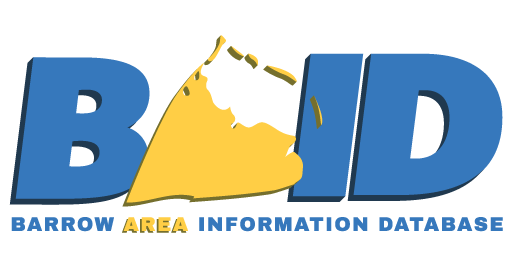The Barrow Area Information Database (BAID) was initiated in June, 2000 and currently includes the locations of over 12,000 research plots and instrument locations. This ongoing effort incorporates both new research locations and sampling sites dating back to the 1940s. Over 30 graduate and undergraduate students have participated in the collection of this information.
The BAID project continues to maintain and enhance information resources that cater to the research scientist. BAID is also developing decision support tools and information customized for the Barrow community. Current activities are funded by the U. S. National Science Foundation and Alaska Coastal Impact Assessment Program. The goals and objectives associated with each facet of the project are described below.
Development and innovation of the Barrow Area Information Database (BAID): A cyberinfrastructure that supports arctic science, outreach and education This project will continue to develop an end-to-end operational cyberinfrastructure (CI) that provides users with tools and systems for sustained access and analysis of current and diverse information and data about the Barrow area. Our overarching goal is to enhance virtual scientific and other collaboration and to meet the current and growing needs of our user community through the maintenance, development of the Barrow Area Information Database.
1. Continue to liaise with users to identify, prioritize and meet their needs for field data collection, data layer generation, and DGPS surveys and mapping support. 2. Maintain the existing suite of BAID applications and develop a new mapping application that will update the former BAID Internet Map Server (BAID-IMS) to offer a faster, user-friendly web interface with improved scalability, functionality and stability. 3. Update aging hardware supporting BAID. 4. Improve the interoperability of BAID with other Arctic data and CI through improved work flows, web services, and use of controlled vocabularies 5. Establish direct links from BAID to external data at the NSIDC and develop, test and establish a range of protocols that will enable CI like BAID to link to data archived at such data centers. 6. Train the next generation of environmental and computer scientists at a leading minority-majority university and conduct extensive education and outreach to advertise BAID and better inform and train the BAID user community. Coastal Impact Assessment Program Expand capacity for informed, multi-stakeholder environmental decision making on Ukpeaġvik Iñupiat Corporation lands in the coastal zone near Barrow, Alaska. 1. Develop a high spatial resolution map of wetlands and conduct coastal erosion studies 2. Expand on an existing web mapping application to develop a new interactive decision support tool for erosion monitoring and coastal development and land management 3. Develop an office with newly trained staff in Barrow capable of improved local mapping and analytical capabilities Any opinions, findings, and conclusions or recommendations expressed in this material are those of the author(s) and do not necessarily reflect the views of the National Science Foundation. Funding
This project is made possible with funding from the U.S. National Science Foundation and with qualified outer continental shelf oil and gas revenues by the Coastal Impact Assistance Program, Fish and Wildlife Service, U.S. Department of the Interior.Collaborative Research
Goal
Objectives
Barrow Area Information Database (BAID) Decision Support Tools Development
Goal
Objectives
Partners

CIAP

STATE OF ALASKA

US FISH AND WILDLIFE

UMIAQ

INSTAAR

























